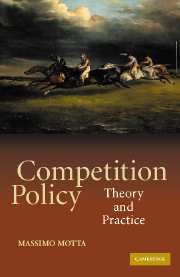Book contents
- Frontmatter
- Dedication
- Contents
- List of Figures
- List of Tables
- Preface
- Acknowledgements
- List of Abbreviations
- 1 Competition Policy: History, Objectives, and the Law
- 2 Market Power and Welfare: Introduction
- 3 Market Definition and the Assessment of Market Power
- 4 Collusion and Horizontal Agreements
- 5 Horizontal Mergers
- 6 Vertical Restraints and Vertical Mergers
- 7 Predation, Monopolisation, and Other Abusive Practices
- 8 A Toolkit: Game Theory and Imperfect Competition Models
- Bibliography
- References to Cases and Legislation
- Index
4 - Collusion and Horizontal Agreements
Published online by Cambridge University Press: 05 August 2015
- Frontmatter
- Dedication
- Contents
- List of Figures
- List of Tables
- Preface
- Acknowledgements
- List of Abbreviations
- 1 Competition Policy: History, Objectives, and the Law
- 2 Market Power and Welfare: Introduction
- 3 Market Definition and the Assessment of Market Power
- 4 Collusion and Horizontal Agreements
- 5 Horizontal Mergers
- 6 Vertical Restraints and Vertical Mergers
- 7 Predation, Monopolisation, and Other Abusive Practices
- 8 A Toolkit: Game Theory and Imperfect Competition Models
- Bibliography
- References to Cases and Legislation
- Index
Summary
INTRODUCTION
Collusive agreements can take different forms: firms might agree on sales prices, allocate quotas among themselves, divide markets so that some firms decide not to be present in certain markets in exchange for being the sole seller in others, or coordinate their behaviour along some other dimensions. Institutional arrangements to sustain collusion might range from a very well organised cartel-like structure where a central office (secret, if anti-trust laws exist) takes the main decisions, to situations where firms merely find some form of communication to sustain the agreement. Further, a collusive outcome might be sustained even in a situation where firms never meet to discuss prices or never exchange sensitive information (but I shall argue that in such a case, labelled “tacit collusion”, the law should not intervene.)
Collusive practices allow firms to exert market power they would not otherwise have, and artificially restrict competition and increase prices, thereby reducing welfare. Accordingly, they are prohibited by any anti-trust law, and a large part of the anti-trust authorities' efforts is devoted to fighting such practices. However, while any serious anti-trust authority would certainly attack a cartel or an explicit agreement among competitors to set prices, or share markets, there might be divergences as to the standard of proof required in less blatant infringements of the law, and as to the treatment of cases where firms manage to keep prices high without overtly colluding.
The main purpose of this chapter is to identify the main mechanisms behind collusion, to study the factors which facilitate it, and to explain which behaviour should be treated as an infringement of the law and which one should not. I shall also analyse what actions anti-trust authorities should take in order to deter and break collusion.
The chapter is structured in the following way: Section 4.1.1 briefly sketches the main features of collusion from an economic point of view. Section 4.2 investigates the industry features, contractual characteristics, and other factors that make collusion more likely to occur.
- Type
- Chapter
- Information
- Competition PolicyTheory and Practice, pp. 137 - 230Publisher: Cambridge University PressPrint publication year: 2004
- 1
- Cited by



